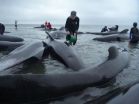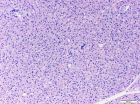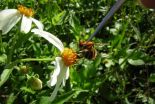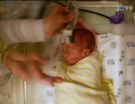(Press-News.org) Biologists since Aristotle have puzzled over the reasons for mass strandings of whales and dolphins, in which groups of up to several hundred individuals drive themselves up onto a beach, apparently intentionally. Recent genetic research has shed some light on whether family relationships play a role in these enigmatic and often fatal beachings of otherwise healthy whales.
One hypothesis regarding the reason for strandings is that "care-giving behavior," mediated largely by family relationships, plays a critical role. In this scenario, the stranding of one or a few whales, because of sickness or disorientation, triggers a chain reaction in which healthy individuals are drawn into the shallows in an effort to support their family members.
A recent study published in the Journal of Heredity (DOI:10.1093/jhered/est007) questions this explanation, using genetic data to describe the kinship of individual long-finned pilot whales involved in mass strandings in New Zealand and Tasmania. The largest of these strandings included more than 150 whales, all of which died.
The study found that stranded groups are not necessarily members of one extended family, evidence that contradicts the hypothesis that stranding groups all descend from a single ancestral mother. Further, many stranded calves were found with no mother in evidence.
Long-finned pilot whales are the most common species to strand en masse and it has long been assumed this tendency was related to the species' social organization. Previous studies have shown that pilot whales have a matrilineal social organization, in which neither males nor females disperse from the group into which they were born. This group structure is also found in killer whales, but is otherwise thought to be rare in mammals.
"If kinship-based social dynamics were playing a critical role in these pilot whale strandings, first, we would expect to find that the individuals in a stranding event are, in fact, all related to each other. Second, we would expect that close relatives, especially mothers and calves, would be found in close proximity to each other when they end up on the beach during a stranding event," explained Marc Oremus of the University of Auckland and first author of the study.
Researchers analyzed both mitochondrial DNA, which is inherited exclusively from the mother, and microsatellite genotypes, which are inherited from both parents, from 490 whales involved in 12 stranding events.
Contrary to the hypothesis that stranding groups consist of whales descended from a single ancestral mother (the "extended matriline" hypothesis), multiple matrilines were found in the groups stranded together.
In some strandings, the researchers assessed the spatial relationships of individual whales on the beach. The position of each stranded whale was mapped to determine if individuals found near each other were related. No correlation was found between location and kinship, even when considering only the location of nursing calves and their mothers, who were often widely separated when the group drove itself onto the shore.
Most surprising was the evidence of "missing mothers" – that is, many of the stranded calves and juveniles had no identifiable mother among the other beached whales.
"Several scenarios could account for the lack of spatial cohesion, including the disruption of social bonds among kin before the actual strandings," commented Oremus. "In fact, the separation of related whales might actually be a contributing causal factor in the strandings, rather than simply a consequence."
The results of this study have important implications for rescue efforts aimed at "refloating" stranded whales. "Often, stranded calves are refloated with the nearest mature females, under the assumption that this is the mother," explained Scott Baker, co-author and Associate Director of the Marine Mammal Institute at Oregon State University. "Well-intentioned rescuers hope that refloating a mother and calf together will prevent re-stranding. Unfortunately, the nearest female might not be the mother of the calf. Our results caution against making rescue decisions based only on this assumption."
The researchers acknowledge an important remaining question: where are the "missing mothers?" Had these adult females successfully refloated or had they never stranded in the first place? To answer this question, the researchers conclude that genetic samples are needed from all whales involved in strandings, including from those individuals that do eventually make it back to sea.
INFORMATION:
Oh mother, where art thou?
DNA profiles show that mass strandings of pilot whales may not be driven by kinship, as previously thought
2013-03-14
ELSE PRESS RELEASES FROM THIS DATE:
Transplanted brain cells in monkeys light up personalized therapy
2013-03-14
MADISON — For the first time, scientists have transplanted neural cells derived from a monkey's skin into its brain and watched the cells develop into several types of mature brain cells, according to the authors of a new study in Cell Reports. After six months, the cells looked entirely normal, and were only detectable because they initially were tagged with a fluorescent protein.
Because the cells were derived from adult cells in each monkey's skin, the experiment is a proof-of-principle for the concept of personalized medicine, where treatments are designed for each ...
Study questions the role of kinship in mass strandings of pilot whales
2013-03-14
NEWPORT, Ore. – Pilot whales that have died in mass strandings in New Zealand and Australia included many unrelated individuals at each event, a new study concludes, challenging a popular assumption that whales follow each other onto the beach and to almost certain death because of familial ties.
Using genetic samples from individuals in large strandings, scientists have determined that both related and unrelated individuals were scattered along the beaches – and that the bodies of mothers and young calves were often separated by large distances.
Results of the study ...
Knowing how brown fat cells develop may help fight obesity
2013-03-14
PHILADELPHIA - Brown fat is a hot topic, pardon the pun. Brown fats cells, as opposed to white fat cells, make heat for the body, and are thought to have evolved to help mammals cope with the cold. But, their role in generating warmth might also be applied to coping with obesity and diabetes.
The lab of Patrick Seale, PhD, at the Perelman School of Medicine, University of Pennsylvania, studies what proteins guide the development, differentiation, and function of fat cells. Seale and postdoctoral fellow Sona Rajakumari, PhD, along with Jun Wu from the Dana-Farber Cancer ...
Social bees mark dangerous flowers with chemical signals
2013-03-14
Scientists already knew that some social bee species warn their conspecifics when detecting the presence of a predator near their hive, which in turn causes an attack response to the possible predator. Researchers at the University of Tours (France) in collaboration with the Experimental Station of Arid Zones of Almeria (Spain) have now demonstrated that they also use chemical signals to mark those flowers where they have previously been attacked.
Researchers at the University of Tours (France) and the Experimental Station of Arid Zones of Almeria (EEZA-CSIC) conducted ...
23andMe identifies multiple genetic factors impacting development of nearsightedness
2013-03-14
Mountain View, Calif. – March 14, 2013 – In the largest ever genome-wide association study on myopia, 23andMe, the leading personal genetics company, identified 20 new genetic associations for myopia, or nearsightedness. The company also replicated two known associations in the study, which was specific to individuals of European ancestry. The study included an analysis of genetic data and survey responses from more than 50,000 23andMe customers and demonstrates that the genetic basis of myopia is complex and affected by multiple genes.
Myopia is the most common eye ...
New early warning system for the brain development of babies published in video journal
2013-03-14
A new research technique, pioneered by Dr. Maria Angela Franceschini, will be published in JoVE (Journal of Visualized Experiments) on March 14th. Researchers at Massachusetts General Hospital and Harvard Medical School have developed a non-invasive optical measurement system to monitor neonatal brain activity via cerebral metabolism and blood flow.
Of the nearly four million children born in the United States each year, 12% are born preterm, 8% are born with low birth weight, and 1-2% of infants are at risk for death associated with respiratory distress. The result ...
CITES makes historic decision to protect sharks and rays
2013-03-14
Bangkok, 14 March 2013. CITES plenary today accepted Committee recommendations to list five species of highly traded sharks under the CITES Appendices, along with those for the listing of both manta rays and one species of sawfish. Japan, backed by Gambia and India, unsuccessfully challenged the Committee decision to list the oceanic whitetip shark, while Grenada and China failed in an attempt to reopen debate on listing three hammerhead species. Colombia, Senegal, Mexico and others took the floor to defend Committee decisions to list sharks.
"We are thrilled with this ...
Statement by WCS president and CEO on historic CITES ruling
2013-03-14
BANGKOK -- March 14, 2013 -- The following statement was issued today by WCS President and CEO Cristian Samper:
The Wildlife Conservation Society (WCS) today celebrates the decision by an historic, broad group of nations from around the world to list five new sharks, freshwater sawfish, and two manta ray species for protection by the Convention on International Trade in Endangered Species of Wild Fauna and Flora (CITES). This vote is a first, critical step in working to ensure that international trade does not threaten the survival of commercially valuable shark and ray ...
Discards ban could impact seabird populations
2013-03-14
The European Parliament recently voted to scrap the controversial discards policy, which has seen fishermen throwing thousands of edible fish and fish waste back into the sea because they have exceeded their quotas.
Scientists at Plymouth University believe this could have a negative impact on some seabirds, which have become used to following the fishing vessels and are increasingly reliant on their discards.
But they say others could return to using foraging as their sole source of food, as long as there are sufficient numbers of fish to meet their needs.
Dr Stephen ...
Chemical chameleon tamed
2013-03-14
How you get the chameleon of the molecules to settle on a particular "look" has been discovered by RUB chemists led by Professor Dominik Marx. The molecule CH5+ is normally not to be described by a single rigid structure, but is dynamically flexible. By means of computer simulations, the team from the Centre for Theoretical Chemistry showed that CH5+ takes on a particular structure once you attach hydrogen molecules. "In this way, we have taken an important step towards understanding experimental vibrational spectra in the future", says Dominik Marx. The researchers report ...
LAST 30 PRESS RELEASES:
Manta rays create mobile ecosystems, study finds
Study: Mixed results in using lipoic acid to treat progressive multiple sclerosis
Norbert Holtkamp appointed director of Fermi National Accelerator Laboratory
New agentic AI platform accelerates advanced optics design
Biologists discover neurons use physical signals — not electricity — to stabilize communication
Researchers discover that a hormone can access the brain by hitchhiking
University of Oklahoma researcher awarded funding to pursue AI-powered material design
Exploring how the visual system recovers following injury
Support for parents with infants at pediatric check-ups leads to better reading and math skills in elementary school
Kids’ behavioral health is a growing share of family health costs
Day & night: Cancer disrupts the brain’s natural rhythm
COVID-19 vaccination significantly reduces risk to pregnant women and baby
The role of vaccination in maternal and perinatal outcomes associated with COVID-19 in pregnancy
Mayo Clinic smartwatch system helps parents shorten and defuse children's severe tantrums early
Behavioral health spending spikes to 40% of all children’s health expenditures, nearly doubling in a decade
Digital cognitive behavioral treatment for generalized anxiety disorder
Expenditures for pediatric behavioral health care over time and estimated family financial burden
Air conditioning in nursing homes and mortality during extreme heat
The Alps to lose a record number of glaciers in the next decade
What makes a good proton conductor?
New science reporting guide published for journalists in Bulgaria
New international study reveals major survival gaps among children with cancer
New science reporting guide published for journalists in Turkey
Scientists develop a smarter mRNA therapy that knows which cells to target
Neuroanatomy-informed brain–machine hybrid intelligence for robust acoustic target detection
Eight SwRI hydrogen projects funded by ENERGYWERX
The Lundquist Institute and its start-up company Vitalex Biosciences Announces Strategic Advancement of Second-Generation fungal Vaccine VXV-01 through Phase 1 Trials under $40 Million Competitive Con
Fine particles in pollution are associated with early signs of autoimmune disease
Review article | Towards a Global Ground-Based Earth Observatory (GGBEO): Leveraging existing systems and networks
Penn and UMich create world’s smallest programmable, autonomous robots
[Press-News.org] Oh mother, where art thou?DNA profiles show that mass strandings of pilot whales may not be driven by kinship, as previously thought



